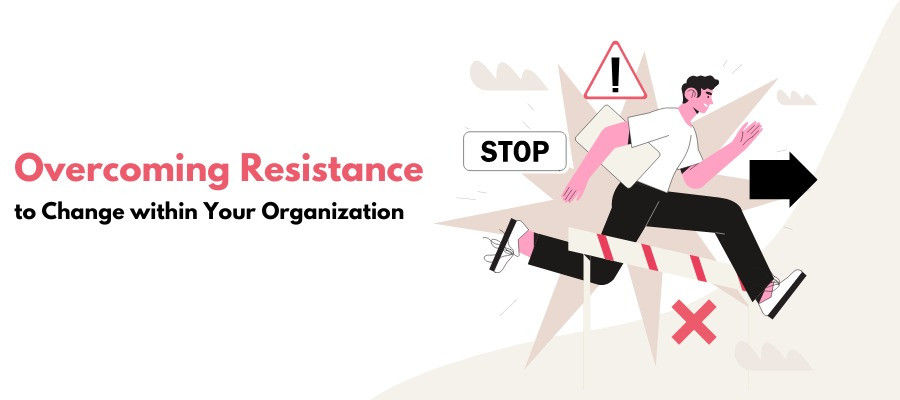Overcoming Resistance to Change within Your Organization

For many organizations, implementing change can be a daunting task, especially when it involves multiple people and locations. Whether the changes are minor or significant, it's crucial to consider the human aspect of the Transformation and how it will affect the people involved.
Before implementing any change initiative, it's important to consider the challenge of overcoming resistance to change. People tend to be resistant to change due to the fear of the unknown and the disruption to their routine, and this can negatively impact the success of the change. Leaders must be aware of these reactions and have a strategy to address the emotional impact of organizational change. It's essential to focus on the people and their needs rather than solely on the structure and design of the change plan.
What Is Resistance To Change?
Resistance to change refers to the reluctance or unwillingness of individuals or groups to adapt to new situations or ways of doing things. This resistance can be seen in relationships, individuals, or organizations. It is often rooted in fear of the unknown, which can trigger anxiety due to the human need for predictability and patterns. There are several common reasons for resistance to change that organizations should understand to address it effectively.
These include a lack of trust in leadership or the organization, poor communication, emotional responses, fear of failure, surprises, and constant change. Here is how it affects:
- One reason for resistance to change is a lack of trust in the leadership team or the organization. This can occur due to a new leader within the organization or previous experiences that have caused employees to distrust leadership.
- Poor communication can also lead to resistance, causing employees to become defensive and lack trust in leadership. Emotional responses, such as fear, uncertainty, and worry, are common, and ignoring or avoiding them can cause confusion or overwhelm.
- Fear of failure can cause resistance to change, as employees worry about negative implications for job security, performance reviews, and pay. Surprises can also cause resistance, as employees prefer predictability and stability in their work and personal lives.
- Constant change can lead to resistance, as employees are less likely to fully adapt to and accept future changes if they are constantly occurring.
To effectively address resistance to change, organizations can leverage data to demonstrate the need for improvement and implement change in phases. Gradual rollouts allow employees to adapt to the change and give leaders time to answer questions and address any issues in advance.
Strategies for Building a Culture of Continuous Improvement
- Give Employees a Voice
Overcoming resistance to organizational change requires effective communication, and listening to employees is a crucial first step. Allowing employees to share their thoughts, concerns, and suggestions can help alleviate frustration and confusion, and their perspectives can be invaluable in guiding the change initiative.
- Clearly Define Reasons for Change
We are defining the why, what, and how behind the change, and communicating this to employees is essential. A communication strategy should target each department or employee audience, emphasizing how the change will ultimately benefit them in the long run.
- Build Excitement for Change
Leaders must communicate the need for change passionately and wholeheartedly to build excitement and optimism within the organization. Fostering an optimistic sentiment for change is vital, as apprehension can undermine effective change.
- Prioritize Employee Interests
Prioritizing employee interests and incentives is critical to gaining their support for change. Leaders should focus on employee adoption rather than solely on the new process or workflow, emphasizing what employees can do with the new system's help.
- Delegate Change Management
Inspirational leaders can fight the resistance to change by establishing a company culture that prioritizes change management. Training natural leaders within the organization can serve as influential role models for the rest of the employees, making overcoming resistance an integral part of the culture.
- Use Data to Support Change
While resistance to change is often an emotional response, data can be a powerful tool to supplement communication. Encouraging employees to review data and analytics can provide transparency and demonstrate the need for change logically and objectively.
- Implement Change Gradually
Change in the workplace should occur gradually and in phases, allowing employees to adapt to new ways of working one step at a time. A longer and more strategic rollout can allow leaders to address concerns or questions and ensure a smoother transition. A radical shift in direction can be disruptive and increase resistance to change.
Conclusion
Both employees and employers can face challenges when it comes to change, but by taking proactive measures and planning, it can be successfully managed. Effective communication between leadership and employees is key, and companies need to listen to their employees and address their concerns to navigate any potential resistance to change.
Reference
- https://www.blueprintrf.com/strategies-overcoming-resistance-to-organization-change/
- https://www.betterup.com/blog/resistance-to-change



